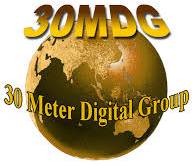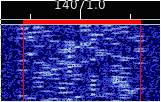Digital Modes Meanderings
Digital Modes Exploration – PSK and MFSK16
PSK31
The typical entry point for a new digital ham operator usually involves starting with PSK31 (or BPSK31 if you prefer) as their first digital soundcard mode and that probably is a good thing. Digital station setups for PSK31will almost always prepare your station for immediate transition to all other soundcard modes. Generally, whatever it takes to perform PSK is usually the same for the other modes as well. PSK31, and its sister variant PSK63, are very popular and easily identifiable modes on the waterfall and you do not have to look hard for a contact. In 2004, I found that the most popular band by far was 20 meters, around 14.070 MHz, followed closely by 40 meters, around 7.070 MHz. That is still pretty much the case even now (in 2014) although 40 meters has morphed a bit since I first became active. Most of the stateside 40 meter activity that once was around 7.070 MHz has since migrated down to the “DX frequencies” around the 7.035 to 7.043 MHz range. Activity on 30 meters was there but usage was sporadic. Finding even PSK contacts was something of a challenge for me at first. Never having been a heavy CW user in the past I had never explored or used 30 meters. I just did not know where to look for digital mode operations. For months I called CQ and searched for a digital mode contact on 30 meters. After 6 months of looking for a contact I finally made my first 30 meters PSK31 QSO! I had been looking far too low in the band and it didn’t help that 30 meters was a sadly under used digital mode band. At that time, most digital mode activity was to be found starting around 10.138 or 10.139 MHz. Now days it starts a bit higher for PSK and MFSK type modes, around 10.140 MHz. Even today in 2014 getting contacts on 30 meters can sometimes be a challenge, even if you know where to look! Some things never seem to change.

30 MDG promotes usage of the 30 meter band >>
Seasonal band operations for the digital modes followed the pattern of the traditional modes (SSB and CW). Typically the low bands (160 to 30 meters) are used in the winter and fall and the high bands (20 to 10 meters) in the spring and summer. However, all the bands have some level of activity so it is worth the while to go explore them all throughout the year. Oddly enough, in spite of my antenna issues relating to HOA (Home Owner Association) restrictions I was mainly operating on 40 and 30 meters with a smattering of 20 meter operations. One would think that getting an antenna operational for the higher bands would be the easier task rather than the mid to low HF bands. That would be correct under normal circumstances but the 11 year solar cycle also entered into the picture. The higher HF bands, 17 meters and above, were all fairly poor to dead. Even the workhorse 20 meter band was dying in the early evening hours. So most of the digital activity (and probably all other modes as well) were concentrated on the low bands. Crappy propagation and noise dominated the upper HF bands for a long time. Consequently, 40 meters was hopping most nights and PSK was predominately the mode of choice for many.
MFSK16
In mid-2005 I was introduced to the MFSK16 digital mode. This was a real game changer for me and my digital mode operations. MFSK16 quickly became my favorite digital mode. I did not know it at the time but this was leading me on a new digital mode path. MFSK16 was astounding in performance compared to the popular PSK modes. It offered a big boost in reduced error copy. PSK modes in general are poor in the error free copy category when the band conditions are poor. Even QPSK, an improved but not very popular variant of PSK, is not much better. MFSK16 stands for multiple frequency shift keying and it uses 16 different tones for sending and receiving the digital information. At 316 Hz, MFSK16 is quite a bit wider in bandwidth than PSK31 which runs at 62.5 Hz bandwidth (that is not a typo, PSK has 31.25 Hz bandwidth only during transmit idle). MFSK16 was (and still is) a marked improvement in copy ability. It uses full time FEC (forward error correction) and is very good on long DX (distance) paths where QSB (fading) and multi-path reception usually degraded the copy of other digital modes. There was not a lot of MFSK16 activity compared to PSK31 but there was a growing following of hams using and appreciating the MFSK type modes. I was one of those hams. As more types of MFSK modes were released to the general ham population more digital mode operators became believers and supporters of this form of digital communications.

